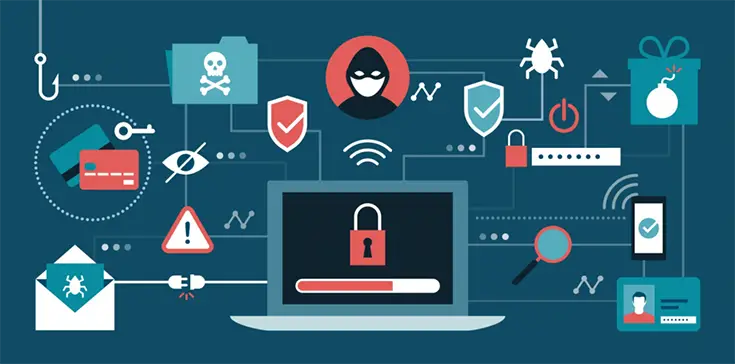Malware – a contraction of malicious software – is any software designed specifically to cause damage to a computer. There are several types of malware – codes including viruses, worms, spyware, Trojan horses, ransomware. Each of these can be installed by hackers on your company’s or home computer. Millions fall victim to malware threat every year and your company may not be an exception. Yet, few know exactly what malware is, what it does and how to proceed. What exactly does malware do?
The malware topic was frequently addressed in this blog: you can click here for a list of malware-related posts, including the how to protect your system against malware guide. In this article, I will guide you through what malware can do, the most common (and noticeable) symptoms of malware activity on your machine, and - last but not least - how to prevent & protect your business from malware attacks.
What can Malware Do?
In a nutshell, malware can wreak immeasurable havoc on a computer network. Hackers send malware into computers to delete files, access passwords and make computers inoperable. Below is a list of some malware capabilities.
Get Access to Restricted Information
Generally, malware is used to steal sensitive information. Sensitive information can be accessed through malware, especially spyware and Trojans.
Information theft is a very serious and costly reward of malware attacks. Over 1, 000 data breaches occurred in the past year alone in attacks on government operations, industries and different businesses. Hackers can gather information such as passwords, credit card numbers, social security numbers, browsing history and other sensitive data to sell to third-party sources.
Track your Online Browsing Data
Some malware are designed to specifically monitor a user’s browsing data. These kinds of malware are known as a spyware programs and they are different from viruses in that they don’t spread but generally exploit security holes; they are installed, hidden and packaged together with unrelated user-installed software. As a matter of fact, sometimes they act as an hidden feature of a well-known software released and/or distribuited even by famous, unsuspected brands. A perfect example of that is the (in)famous Sony BMG rootkit, which was an unintended spyware.
Restrict Access to Data
Ransomware is the name of the malware that restricts access to your data. Like the name suggests, this malware holds your files at a ransom. When ransomware affects an infected computer system, the owner of the malware will demand a certain sum of money to be paid before the files are released.
Slow Down your Computer
You may notice that a large chunk of your computer’s memory is consumed without you having added any significantly huge data. Many malware types replicate themselves and fill your hard drive, leaving little space for legitimate programs. The loss of space on a computer can make it very sluggish and makes carrying out tasks difficult.
Spread throughout Computer
Worms are malware designed to spread throughout a computer network. A worm is very disruptive; once it infects a computer, it replicates itself and spreads throughout your computer network. For most companies that operate all their devices on a single network, the worm would then not just damage one computer, the entire organizations’.
Symptoms of Malware
Different malware have different forms, so they will look different for everyone. However, some of the more general symptoms of a malware infection include;
Lack of Hard Disk Space
Running out of hard disk space is a common issue faced by all computer users. However, if this happens faster than you anticipated, then you need to check for malware. Malware replicate themselves and work overtime so that your hard disk is filled up quickly.
Slow Computer
This is the most common symptom of a malware infected computer. If your operating system and programs take a while to start up, and data bandwidth suspiciously slow, then it is very likely that your computer is infected with malware.
Pop-ups
Another common symptom of a malware infection on a computer is pop-ups. Pop-ups are unexpected, annoying messages that will keep appearing on your computer screen and are difficult to get rid of. Pop-ups come with lots of danger, most of which we cannot see.
Computer Freezing and Crashing
This could be caused by either technical incompatibility or malware issues. If it is not a software and hardware issues, then it is a malware issue. You will need to run a good malware removal tool to scan your computer.
Blue Screen of Death (BSOD)
A blue screen of death generally has two causes; a technical problem with your system or malware infection. To check what caused your last BSOD, go to Control Panel > System and Security > Administrative Tools > Event Viewer and select Windows Logs. Those marked with an “error” are the recorded crashes.
How to Prevent Malware Infections
Here are some steps you can take to minimize malware threats.
Install a Malware Removal Tool
This goes without saying that you should have a good malware removal tool installed on your computer. Anti-malware tools are very effective at spotting and removing different types of malware. They may not always find every harmful program on your computer, but regular checks with these tools will make your computer network safer. Considering that privacy invasion is also a serious threat, you should also get yourself with a good spyware removal tool to minimize the negative impact of any spyware software.
Beware of Pop-ups
Generally, pop-ups are and links are made to be enticing or urgent and many click them without a second though. But they usually carry malware that can be installed on your computer. So, read before you click.
Update your System
It is very essential to keep your operating system and antivirus as updated as possible. This is because nearly a million new malware threats are created daily. So, check regularly if there are new updates.
Practice Safe Browsing
In the long-term, this may protect you from online threats. Make sure to set a strong password and use password managers. Always browse the internet on a secure connection and log out of websites after you’re done.
Implement Network Security
IT systems management us a very useful approach and is essential for guarding your data from hackers. Implement this approach to make your network safer.
Conclusion
That's basically it: I definitely hope that this post will help administrators, IT enthusiasts and end-users to increase their overall knowledge about the malware threat.



